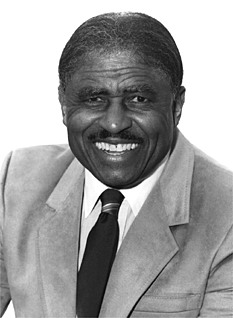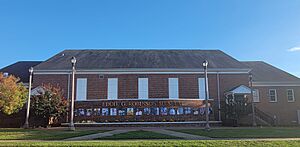Eddie Robinson (American football coach) facts for kids

Robinson c. 1980
|
|
| Biographical details | |
|---|---|
| Born | February 13, 1919 Jackson, Louisiana |
| Died | April 3, 2007 (aged 88) Ruston, Louisiana |
| Alma mater | Leland College University of Iowa |
| Coaching career (HC unless noted) | |
| Football | |
| 1941–1997 | Grambling State |
| Basketball | |
| 1943–1956 | Grambling State |
| Head coaching record | |
| Overall | 408–165–15 (.707) (football) |
| Bowls | 9–6 (.600) |
| Tournaments | 0–3 (.000) (NCAA DI–AA playoffs) |
| Accomplishments and honors | |
| Championships | |
17 SWAC (1960, 1965–1968, 1971–1974, 1977–1980, 1983, 1985, 1989, 1994) |
|
| College Football Hall of Fame Inducted in 1997 (profile) |
|
Eddie Gay Robinson Sr. (born February 13, 1919 – died April 3, 2007) was a famous American football coach. He was the head coach at Grambling State University for 56 years. This university is a historically black university (HBCU) in Grambling, Louisiana. Many experts believe Robinson was one of the greatest college football coaches ever.
During a time when black players could not play for many southern college teams, Robinson made Grambling State a football powerhouse. He retired in 1997 with an amazing record of 408 wins, 165 losses, and 15 ties. He coached every game from the field. In 1997, he was added to the College Football Hall of Fame. He is one of the most successful college football coaches in history.
Contents
Who Was Eddie Robinson?
Early Life and Education
Eddie Robinson was born in Jackson, Louisiana. His father was a sharecropper, and his mother was a domestic worker. He finished McKinley Senior High School in Baton Rouge, Louisiana in 1937.
He played quarterback at Leland College and earned a degree in English. Later, he got his master's degree from the University of Iowa in 1954.
Starting His Coaching Career
Robinson always dreamed of being a college football coach. But because he was black during the time of Jim Crow laws, it was very hard to find a job. He could only coach at schools for black students, and those jobs were usually taken.
He worked at a feed mill for a short time. Then, he heard that Louisiana Negro Normal and Industrial Institute needed a football coach. This school is now Grambling State University. He applied and got the job.
Robinson's Impact on Football
Building a Team from Scratch
In 1941, at just 22 years old, Robinson became the head football coach. Back then, there were no many assistant coaches. So, Robinson did everything himself. He taught offense and defense, mowed the field, and even made sandwiches for his team. He also wrote game stories for newspapers.
He had very high standards for his players. They had to behave well and do well in school. In his first year, the team won 3 games, lost 5, and tied 1. But in the next season, after he found new players, his team had a perfect 9–0 record. They were unbeaten, untied, and no team scored against them.
Grambling did not have a team in 1943 or 1944 because of World War II. Robinson returned in 1945. He stayed at the school until he retired in 1997. The school changed its name to Grambling College in 1946 and Grambling State University in 1973.
Developing Future Stars
More than 200 of his players went on to play in the National Football League (NFL) and other professional leagues. He coached three players who later joined the Pro Football Hall of Fame. These were Buck Buchanan, Willie Brown, and Charlie Joiner.
Robinson also coached James Harris. Harris became the first black quarterback to start a season opener in modern professional football. He also coached Willie Davis, a Hall of Fame defensive end. Another famous player was Doug Williams, who won the Super Bowl XXII MVP award. Williams later became Grambling's head coach after Robinson.
Winning Championships
During his long career, Robinson had 45 winning seasons. His teams won or shared 17 Southwestern Athletic Conference championships. They also won nine black college football national championships.
In 1985, Robinson broke the record for most wins by a college football coach. Many people worried he might face hate, like Henry Aaron did when he broke Babe Ruth's home run record. But Robinson said he did not get any hate mail.
Some people wondered if his record was less important because his team played against smaller schools. Robinson explained that he grew up in the South during segregation. He was told where he could go to school and who he could recruit. He said, "I did what I could within the system." His goal was always to win, no matter the league or level.
More Than Just Football
Eddie Robinson had other jobs besides coaching football. He taught at Grambling High School. During World War II, he coached the girls' basketball team. His girls' team almost won the state championship, losing by only one point.
He also coached boys' basketball and baseball. He even directed the band and was in charge of the cheerleaders. All of this was done with a very small budget of only $46.
In the days of segregation, Robinson could pick many of the best black high school football players in Louisiana. He often shared them with Southern University. This made the games between Grambling and Southern a huge rivalry. This rivalry became the Bayou Classic in New Orleans in 1974.
Robinson kept his success even after schools became integrated. He had only one losing season between 1960 and 1990. However, after three losing seasons in the mid-1990s, some people thought he should retire. Fellow coach Joe Paterno once said, "Nobody has ever done or ever will do what Eddie Robinson has done for the game."
In 1997, there were rumors that Grambling planned to fire him during the season. But people spoke out, including Louisiana's governor. So, Grambling let Robinson finish the season before he retired.
Later Life and Legacy
After he retired, Robinson developed Alzheimer's disease. He passed away on April 3, 2007, in Ruston, Louisiana.
Robinson and his wife, Doris, had two children, Eddie Jr. and Lillian Rose. Doris passed away in 2015 at 96 years old.
Awards and Honors
Many awards and places are named after Eddie Robinson.
- In 1979, the Black College All Star Bowl named its award for new NFL players from HBCUs the "Eddie G. Robinson Trophy."
- Grambling's football stadium, built in 1983, is called Eddie Robinson Stadium. A street on campus is also named for him.
- In 1985, a street in Baton Rouge was renamed for him.
- The Football Writers Association of America's Eddie Robinson Award was renamed in his honor in 1997. This award goes to the best college football coach.
- The Eddie Robinson Classic (a football game series) was held from 1997 to 2002.
- The American Urban Radio Networks gives an award for HBCU coaches called the "SBN Eddie Robinson Coach of the Year."
- High school football games called the Eddie G. Robinson Classic series started in 2015.
Robinson also received other important coaching awards. He got the Amos Alonzo Stagg Award in 1982 and 1985. He won the Bobby Dodd Coach of the Year Award in 1992. This award honors coaches whose teams do well on the field, in the classroom, and in the community.
Super Bowl XXXII in San Diego was dedicated to Robinson. He walked onto the field with Doug Williams and Joe Gibbs to do the coin toss.
Museum

In 2010, the Eddie G. Robinson Museum opened at Grambling State University. The museum tells the story of the G-Men football program and Coach Eddie Robinson. It is a large museum, about 18,000 square feet.
In Media
In 1981, a TV movie called Grambling's White Tiger was made. It was about the true story of Jim Gregory, the first white quarterback at Grambling in the 1960s. Harry Belafonte played Eddie Robinson in the movie.
Images for kids
-
Eddie G. Robinson Museum on the campus of Grambling State University



